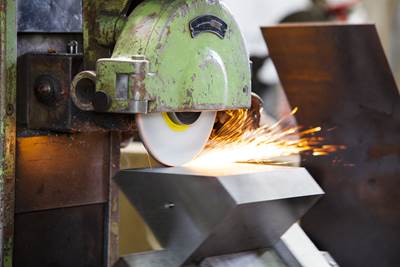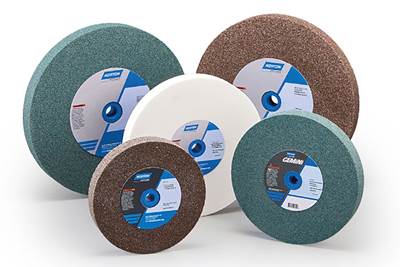Three Key Factors For Stabilizing a Grinding Operation
Improving throughput in grinding takes more than direct increases to material removal rate. It also requires careful consideration of the factors behind the operation’s stability.
Share






Autodesk, Inc.
Featured Content
View More
Hwacheon Machinery America, Inc.
Featured Content
View More





Takumi USA
Featured Content
View MoreFor manufacturing operations to thrive, management must determine how to increase profit and decrease costs in ways that match their shop’s mix of work and equipment. Improving throughput is a relatively universal way to improve profitability, though shops must ensure they still adhere to safety and quality standards. In grinding, this means not only examining the factors behind cycle times and material removal rate (MRR), but those controlling the stability of the operation.

Grinding wheels such as Norton’s Quantum Prime wheels are compatible with many kinds of grinding operations, though the MRR will differ between operations. The company says that its proprietary micro-fracturing ceramic grains and vitrified wheel bond technologies improve wheel life while increasing potential material removal rates. Images courtesy of Norton | Saint-Gobain Abrasives.
MRR, which is measured in cubic inches per minute or cubic millimeters per second, is a measure of the volume of material being removed from a workpiece per unit of time. Norton | Saint-Gobain Senior Application Engineer Taqwa Gilani points to both MRR and its width-normalized form, MRR′, as key indicators of grinding operation productivity. Increases in the infeed rate and depth of cut result in direct increases to MRR, but Gilani also notes that just how high a shop can safely increase these parameters depends on the rest of the factors surrounding the grinding operation. Factors such as the hardness of the workpiece material, the efficacy of the coolant and other safety systems, the construction of the grinding wheel and more affect how the grinding operation withstands the increasing friction heat and grinding forces as MRR increases — and, ultimately, determine whether the operation successfully produces a part.
Forces and Friction
A higher MRR means the grinding wheel is removing material at a faster rate, subjecting the abrasive grains to higher forces and resulting in increased wear. The increase in forces can also result in more heat being generated during the grinding process. In turn, increased heat in the grinding zone can lead to dimensional inaccuracies as well as scorching, thermal damage to the part that changes its physical properties. Machine deflection and vibration are also closely linked to applications with high grinding forces and low machine stiffness.
Gilani notes that hard materials and wheels can exacerbate these concerns. Diamond is the hardest naturally occurring material on earth, and CBN (cubic boron nitride) is extremely hard as well. Wheels that use these materials for abrasive grains can lead to much higher friction during grinding. Similarly, hard materials impose greater resistance on the grinding wheel, leading to increased grinding forces and — especially in materials with low thermal conductivity — heat generation. Without taking steps to counterbalance this, users must reduce the forces by lowering the feed rate, which in turn decreases the MRR.

Higher MRR means higher productivity, but sometimes shops can benefit from a lower MRR. Targeting a lower MRR enables a more controlled material removal, leading to smoother cutting paths and reduced grinding marks on the surface of the part.
Shops can mitigate these issues in several ways, Gilani says, including through proper lubrication, dust collection systems, choice of abrasive grain type and choice of wheel construction.
Stabilizing the Grinding Operation
Coolant, Lubrication and Operational Safety
Coolant and lubrication can lessen friction and heat issues, with increased effect in grinding applications with harder wheel grains and materials. The increased stability of operations with proper coolant and lubrication enables shops to push infeed rate and depth of cut higher, increasing productivity.
Straight oil is usually a better choice than water-soluble coolants for high-MRR applications, Gilani says, as oil provides far more lubrication and heat dissipation quality. The decrease in friction also lowers grinding forces on grains, enabling shops to take advantage of greater MRR without seeing extreme drops in wheel life. With lower heat and forces in the grinding zone, users can also see improvements to surface finish at high feed rates.
Grinding operations also create dust, with the amount increasing alongside MRR. The absence of an effective mist or dust collection system can lead to shopfloor staff inhaling harmful dust, resulting in respiratory issues. Additionally, the combination of increased heat and sparks at high MRR poses a fire hazard, particularly when grinding in oil. Dust collection system and fire suppressant systems are therefore vital for ensuring the safety and reliability of grinding operations.
This graph is a representation of the force required to microfracture abrasive grains of different types. Because they display a higher threshold force (indicated by the Y-intercept on the graph) compared to conventional abrasives, microfracturing ceramic grains requires greater force at low MRR. Beyond a certain MRR, however, these grains tend to demonstrate lower specific cutting energy and fracture more easily than their conventional counterparts.
Abrasive Grain Type
At high-enough MRR, grinding forces can microfracture abrasive grains, enabling them to cut more freely. Gilani says this is particularly notable with ceramic grains, which can see reduced performance at low MRR due to their high threshold force compared to standard grains. As MRR increases, however, the power required to microfracture ceramic grains increases much slower than for conventional abrasives, and ceramic grains become better able to maintain sharpness and grinding performance.
Certain types of grain materials can also demonstrate cooling properties to reduce heat buildup during grinding, and versatility in grain shapes and sizes can improve cutting efficiency.
Wheel Bond and Construction
Vitrified grinding wheels, which are produced by fusing specially chosen clays with abrasive grains at high temperatures, tend to be more durable and hold their form better than other types of grinding wheels. These also can have a more porous surface, which makes chip removal simpler, thereby reducing load and grain wear as MRR climbs.
Lighter wheel materials also reduce the load on the spindle, enabling more aggressive grinding conditions for improved productivity.
Optimizing the Full Grinding Operation
Despite only infeed rate and depth of cut having a direct effect on MRR, the productivity of a job depends just as much on the other aspects of a grinding operation — and the surface finish and overall quality of the job depends largely on these aspects. Reducing heat and forces in the grinding zone by focusing on operational stability also extends wheel life, saving on tooling costs. Paying attention to operational factors like coolant, dust collection systems, abrasive grain types and wheel construction therefore helps shops optimize both their processes and their profitability while maintaining a safe grinding environment and satisfying customer expectations, part after part.
Related Content
Orthopedic Event Discusses Manufacturing Strategies
At the seminar, representatives from multiple companies discussed strategies for making orthopedic devices accurately and efficiently.
Read MoreHigh RPM Spindles: 5 Advantages for 5-axis CNC Machines
Explore five crucial ways equipping 5-axis CNC machines with Air Turbine Spindles® can achieve the speeds necessary to overcome manufacturing challenges.
Read More5 Tips for Running a Profitable Aerospace Shop
Aerospace machining is a demanding and competitive sector of manufacturing, but this shop demonstrates five ways to find aerospace success.
Read More6 Machine Shop Essentials to Stay Competitive
If you want to streamline production and be competitive in the industry, you will need far more than a standard three-axis CNC mill or two-axis CNC lathe and a few measuring tools.
Read MoreRead Next
Machining 101: What is Grinding?
Grinding takes an abrasive — often attached to a wheel — and uses its many grains to cut a workpiece. Variations on this process are useful for a wide variety of applications.
Read More7 Key Factors in Choosing a Grinding Wheel
The grinding wheel market is wide, but seven application factors can help users narrow the market to the wheels they need.
Read MoreAbrasives Supplier Provides Automation Consultation
Recognizing the demand for automation solutions in grinding and finishing applications, this abrasives manufacturer is providing free consulting services to help shops develop automated processes.
Read More


.png;maxWidth=150)



























.jpg;maxWidth=300;quality=90)










